Lost in Space
Where Afrofuturism fused experimental music and the sci-fi imaginary to probe a near future lived beyond the categories of race, the ICA’s recent exhibition Alien Nation explored the nexus of sci-fi and art through the lens of race – an approach that could only reinforce the category. Review by Richard Hylton
Mother Earth is pregnant for the third time, for ya’ll have knocked her up. I have tasted the maggots in the minds of the universe, I was not offended, for I knew I had to rise above it all or drown in my own shit.
– Maggot Brain, Funkadelic, 1971
Today, science-fiction is such an integral part of cinema (and television) entertainment that it now seems almost impossible to consider one without the other. The legacy of cinema’s ‘sci-fi’ narratives –‘man’s’ inalienable desire to explore and conquer inhabited and uninhabited worlds – owes as much to literary figures such as Jules Verne and HG Wells as they do to cinema. In different ways, both Verne and Wells used science-fiction to tell stories which were commentaries on the present; namely the rapid technological and industrial advancements of the late 19th century. Where Verne’s vision tended towards a celebration of technological ‘progress’, Wells’ futuristic novels viewed technological ‘progress’ with a greater degree of scepticism, as a threat to humanity. Fritz Lang’s Metropolis (1927) is an early example of how the allegorical powers of science-fiction would be used in cinema. Made during the rise of communist and fascist ideologies, Lang adopted Wells’ sceptical theme in his nightmarish vision of a future society in which technology governed all but the elite.
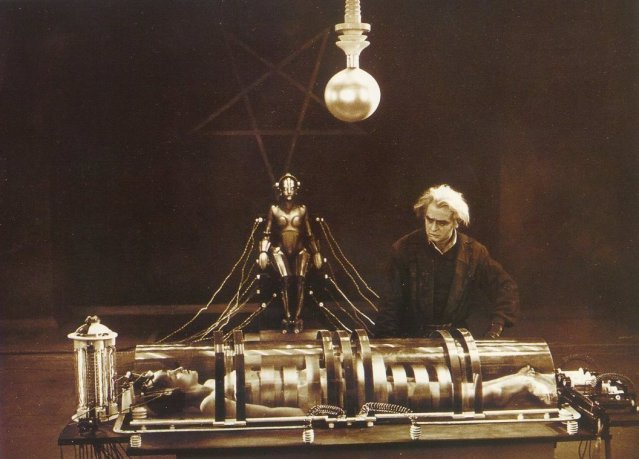
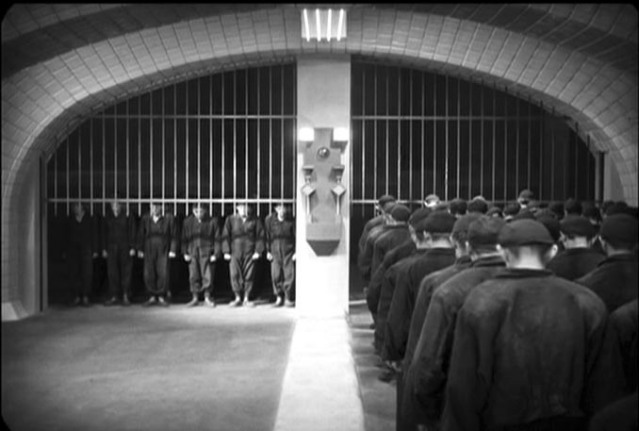 Image: Stills from Fritz Lang’s Metropolis, 1927
Image: Stills from Fritz Lang’s Metropolis, 1927
By the 1950s, with cinema (Hollywood in particular) going into ‘sci-fi’ overdrive, countless films reprised many of literature’s popular science-fiction themes: time travel, space exploration and alien invasions. This period coincided with the advent of the Cold War and the spread of paranoia, hysteria and fears of communist infiltration, Soviet espionage and nuclear annihilation. Nothing more typified this hysteria than the McCarthy witch-hunts in the United States where it was considered fair game to relentlessly hound anyone and everyone thought to be either a Communist, Communist sympathiser or, in some way, a threat to government. Against this political backdrop, films such as Invasion of the Body Snatchers (1956) and It Came from Outer Space– in which humans had succumbed to alien invaders – represented allegories for a prevailing climate of doom and fear. (1953) reflected how elements of ‘sci-fi’ cinema
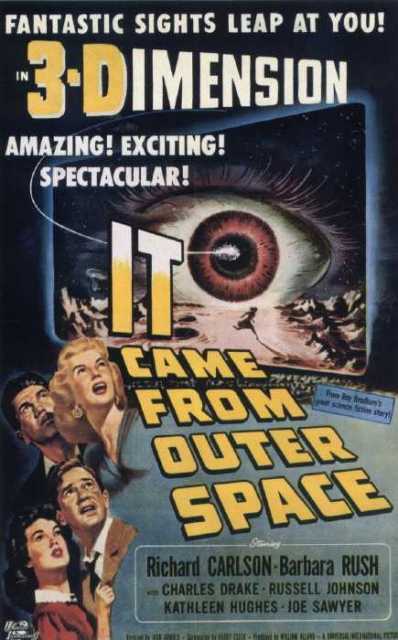 Image: Film poster for Jack Arnold’s It Came From Outer Space, 1953
Image: Film poster for Jack Arnold’s It Came From Outer Space, 1953
Using this cinematic legacy as its anchor, the exhibition Alien Nation featured 12 internationally-based artists (including the late Hamad Butt) working with painting, photography, video, film and sculpture. Monitors in the ICA’s lower gallery played exerts from these classic ‘sci-fi’ films, whilst a series of ‘original film posters from 1950s sci-fi cinema classics’ lined the ICA’s concourse space. If this archival material illustrated how barmy the 1950s were, the inclusion of Orson Welles’ 1938 radio adaptation of HG Wells’ The War of the Worlds, originally broadcast in ‘real-time’, was a reminder that the fear of alien invasion pre-dated the onset of the Cold War. Welles had to apologise for sparking hysteria amongst radio audiences who believed the world was about to be taken over.
In the exhibition brochure we are told that the show explored ‘the complex relationship between science fiction, race and contemporary art.’ We are also informed that, ‘The artworks on display expose a disturbing contemporary narrative in which the media perpetuate a terror of “invasion” from immigrants and asylum seekers (indeed any racial, cultural or ethnic “other”), positioning such “outsiders” as the dominant threat to both family and national stability.’
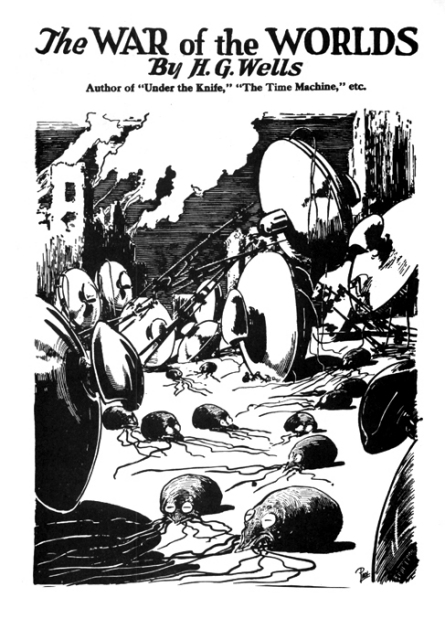 Image: Cover of H.G. Wells’ The War of the Worlds
Image: Cover of H.G. Wells’ The War of the Worlds
Dominating one wall of the lower gallery space was Brown and Proud (2006), a large monochrome drawing by American artist Mario Ybarra Jr. Amongst the mêlée of visual references to gang culture, graffiti art and the political mural was the unlikely coupling of Star Wars’ Chewbacca and the legendary Mexican revolutionary, Emiliano Zapata. Where Chewbacca was portrayed smoking a cigar and sporting a baseball cap, Zapata stared out at us, head wrapped in a bandana, performing the sort of hand salute associated with Los Angeles gang-life. The exhibition brochure informed us that for Ybarra ‘this partnership represents the coalition of political revolt and popular culture as a strategy for resistance against more conventional and political structures.’ Despite such succinctness, it was hard not to wonder if the curators or artist considered the gallery to be outside these same structures. Less physically imposing within the gallery, but, nonetheless effective in its simplicity, was Kori Newkirk’s beaded curtain. Made up from countless black pony beads held together with strips of artificial braided hair, Merk (2006) depicted a mosaic-like image of an ‘iconic suburban landscape’. Disrupting what ordinarily would have been an almost benign monotone image was a yellow shaft of light which cut through the its centre, as if to suggest the arrival (or departure) of something untoward.
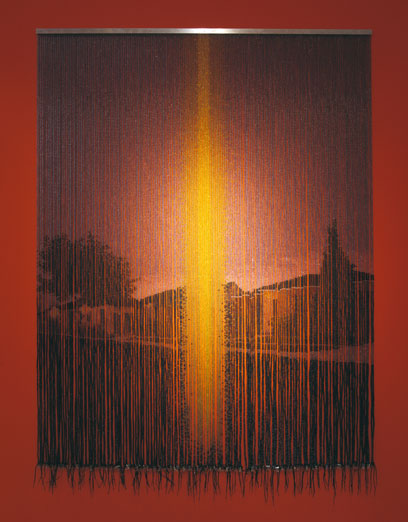 Image: Kari Newkirk, Merk, 2006
Image: Kari Newkirk, Merk, 2006
Henna Nadeem’s, A Picture Book of Britain (2006) consisted of a series of photographs of the British countryside, taken from books produced by Country Life magazine from the late 1930s to the 1980s. What we are looking at – picturesque Britain – is familiar yet, also at times, visually impenetrable. Each photograph has been transformed by way of digital montage in which an original image is overlaid with an abstract pattern usually cut from a duplicate image. Nadeem’s patterns are themselves derived from various artistic and cultural traditions, such as William Morris designs or Japanese and Islamic motifs. Although roughly continuing in the same vein as Nadeem’s previous work, when seen in situ (as opposed to reproduction), however, one notable difference is revealed. Where Nadeem’s earlier collages were one-off works – each pattern individually hand-cut and collaged over an ‘original’ image –this new body of work has been entirely digitally produced; gone are the marks made by the scalpel, the joins, tears, awkward fidgety cuts and montage. Although some of the ‘unique’ charm evident in Nadeem’s earlier work has been lost to technology, the digital process makes way for an even more fanciful interplay between pattern and image. In keeping with her previous works, these digital montages do still possess a strange visual allure. However, the relationship between Nadeem’s work and the show’s theme did come across as slightly tenuous, even if the curators felt compelled to introduce Nadeem as a ‘British Muslim’ who had grown up ‘in semi-rural Yorkshire.’ Such a description appeared to function more for the benefit of the show’s thesis than the artist’s work.
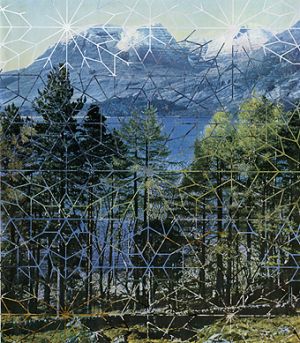 Image: Henna Nadeem, from the series A Picture Book of Britain, 2006
Image: Henna Nadeem, from the series A Picture Book of Britain, 2006
Taking over one of the ICA’s upper gallery spaces was Hew Locke’s recent work Golden Horde (2006). A series of boat and plane-like forms, assembled from copious amounts of plastic toys – swords, guns, dolls, jewellery baubles and flowers – perched on plinth-like wooden structures arranged in a circle. Described fulsomely in the exhibition publicity as a ‘dystopian vision of the future’, these ornate plastic jumbles seemed also to revel in their comic simplicity. Colourful, glittery and shiny Christmas tree decorations undergo various forms of transformations by Brazilian artist, Marepe. In Untitled (2002-04) cheap and equally fragile looking objects – the product of cheap labour in Brazil – were assembled into small hybrid forms, reminiscent of miniaturised alien beings and pod-like space modules. Displayed virtually on ground level across a large plinth, Untitled is part ornament, part toy. Hybridity was also a theme in Laylah Ali’s, Untitled (types), a series of oil pastel drawings in which familiar human and animal figures are portrayed as mutant forms. The Triffid (1991) by Hamad Butt featured a short animation of an image taken from a book cover of The Day of the Triffids. Bringing to life an image of the fictitious plant, Butt’s video alluded to the real-life devastation caused by the AIDS virus.
It was evident how much of the work could, in some way or other, be related to science fiction and ‘race’. However, despite the individual merits of the art works, as a group show Alien Nation seemed a little encumbered by its theme. This was apparent for at least two reasons. Firstly the tropes of science-fiction, rather than science fiction as a subject of genuine inquiry, appeared to be more pertinent to the works on display. This had the effect of the art functioning merely as an illustration of a curatorial idea, rather than really being about how contemporary art has embraced the sci-fi genre, in ways comparable to say that of literature, film or music. Secondly, the thematic of ‘race’ was only one amongst a number of ideas being explored by many of artists in the show.
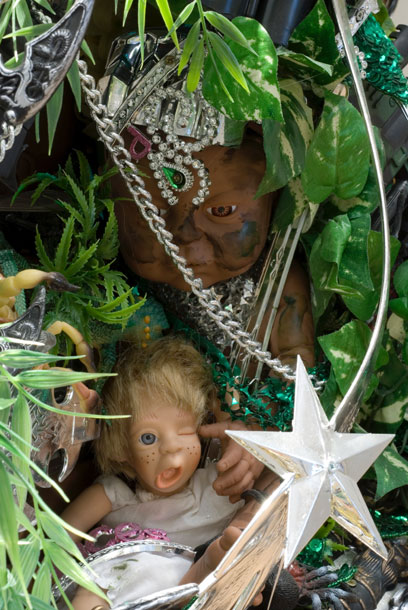 Image: Hew Locke, detail of Golden Horde, 2006
Image: Hew Locke, detail of Golden Horde, 2006
The show might have benefited from a wider appreciation of how the issue of ‘race’ has since (at least) the 1960s been critically incorporated into the science-fiction genre. This has been reflected in the work of novelist Samuel R. Delaney or film-maker George A. Romero. Equally, for Black musical innovators such as Sun Ra (and his solar Arkestra), Funkadelic, Afrika Bambattaa and Kool Keith – to name a few – ‘sci-fi’ is a means through which to think outside of the box; to be artistically promiscuous, fusing different styles and traditions, subverting and pushing the limits and boundaries of popular music. Attitude, mutating personae, humour and downright daftness, this music is underpinned by an assured political and cultural irreverence. Sometimes assisted by mind-altering drugs (particularly in the case of Funkadelic) ‘space is the place’ to transcend earthly tendencies towards (racial) categorisation and a means through which to question, if not entirely escape, such constraints. By erecting racial barriers around art, Alien Nation went against the allegorical spirit and inherent value of science fiction.
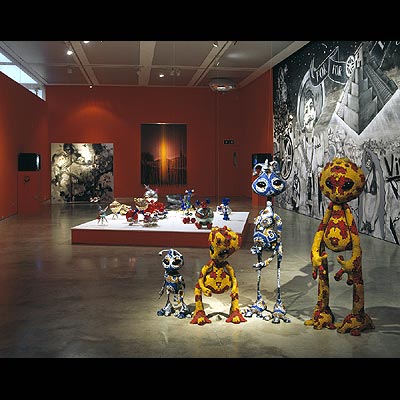 Image: Lower Gallery installation at the ICA. Foreground: Yinka Shonibare, Dysfunctional Family, 1999. Background mural: Mario Ybarra Jr., Brown and Proud, 2006
Image: Lower Gallery installation at the ICA. Foreground: Yinka Shonibare, Dysfunctional Family, 1999. Background mural: Mario Ybarra Jr., Brown and Proud, 2006
Ellen Gallagher & Edgar Cleijine’s 16mm film installation offered a rare glimpse within the show of what could have been, had the curators selected fewer artists and enabled them to make more substantial contributions. Gallagher & Cleijine’s strange but alluring installation comprised five different films, most memorable amongst which was the dreamlike underwater world film, Watery Ecstatic. At times impenetrable, and at other times almost juvenile in humour, this installation was described as invoking ‘the notion of darkness as a phantastical territory.’ Despite such a highfalutin description, this installation extended beyond merely using the tropes and iconography of ‘sci-fi’ to create something more intriguing and less obviously illustrative of the exhibition’s theme. Another more basic reason for this particular installation being more successful, in comparison to many of the objects on display, was that where nine artists were squeezed into the ICA’s lower gallery, Gallaghar & Cleijine were afforded (as was Hew Locke) the luxury of having one of the ICA’s upper gallery spaces to themselves. Although by ICA standards Alien Nation was still a relatively modestly sized show, such a seemingly unequal distribution of space made the show feel rather unbalanced. However, with three curators (John Gill, Jens Hoffman and Gilane Tawadros) plus the ICA and inIVA as producers, it is possible to see why a smaller and possibly more discerning exhibition did not materialise. A case in point was the inclusion of Yinka Shonibare’s Dysfunctional Family (1999) in which a nuclear alien family is portrayed in African fabrics. This work may have once elicited a wry smile, yet because its inclusion in this exhibition seemed as predictable as it may have been obligatory, it also generated a roll of the eyes. Injudicious selections such as this one, diminished rather than enhanced any sense of curatorial flare or originality of thought.
There can be little argument that the issue of ‘race’ (and its corollaries, immigration and asylum seekers) remain an important part of contemporary political discourse. Furthermore, the culture of fear and paranoia pervades all aspects of life; terrorism, global warming, ‘religious extremism’, health and yobs – you name it and government and media alike will remind us to be fearful of it. By fixating on the relationship between science-fiction and ‘race’, Alien Nation limited the reading of the work, reflecting the show’s more insidious problem of being yet another Black ‘survey’ exhibition. Dating back to the 1980s, this particular form of institutional engagement with Black artists today continues to negate any serious and consistent engagement with the majority of Black artists on an individual basis. Back to Black at the Whitechapel Art Gallery (2005) and Africa Remix at the Hayward Gallery (2005) are two recent manifestations of how the English gallery system continues, almost by stealth, to marginalise Black artists with the production of such group exhibitions. Despite its critical pretensions about exploring ‘themes of “otherness” and “difference” through the language and iconography of sci-fi’’, Alien Nation, when all said and done, was yet another one of those unhelpful job-lot ethnic shows which institutions such as the ICA seem all too happy to stage once every five years or so.
Alien Nation, Institute of Contemporary Art, London, 17 November 2006 – 14 January 2007
Richard Hylton <richard.hylton1 AT ntlworld.com> is curator at Unit 2 Gallery, London Metropolitan University. His book The Nature of the Beast: Cultural Diversity and the Visual Arts Sector. A Study of Policies, Initiatives and Attitudes 1976-2006 will be published in March 2007 by ICIA at the University of Bath
Mute Books Orders
For Mute Books distribution contact Anagram Books
contact@anagrambooks.com
For online purchases visit anagrambooks.com






